How to Identify Healthy Snacks Using the FactsScan App
Summary :
Discover how the FactsScan App helps you make smarter snacking choices by instantly analyzing ingredients, nutrition scores, and additives. Learn how this AI-powered tool identifies truly healthy snacks and guides you toward better food decisions with just one scan.
You’re standing in the grocery store snack aisle, scanning shelf after shelf of colorful packaging. One promises “whole grains and natural ingredients.” Another boasts “zero sugar.” A third features a wholesome photo of oats and almonds. But here’s the truth: most of these claims are carefully crafted marketing narratives designed to make processed snacks feel like health food. And honestly? Deciphering what’s actually inside these boxes is nearly impossible without becoming a nutrition scientist.
If you’ve ever felt confused, frustrated, or betrayed by snack labels, you’re not alone. We’ve all bought something we thought was healthy, only to discover it’s packed with hidden sugars, artificial additives, or questionable oils. That’s where FactsScan comes in—a game-changing app that transforms how you shop for snacks. Instead of trusting colorful labels and marketing claims, FactsScan empowers you to see the real nutritional truth in seconds.
Let me show you how.
The Problem: How "Healthy-Looking" Snacks Fool Us
Before we dive into solutions, let’s talk about the problem. Food companies are incredibly savvy at packaging their products to appeal to health-conscious consumers—and they’ve mastered the art of misleading claims.
1. The “Low-Fat” Trap
When a snack is labeled “low-fat,” many of us automatically think it’s healthier. But here’s the catch: when food manufacturers remove fat, they often replace it with added sugars and refined starches to maintain taste and texture. That “low-fat” granola bar might actually contain as much sugar as a dessert.
2. The “Natural” Illusion
Words like “natural,” “organic,” and “wholesome” sound reassuring, but they’re surprisingly unregulated. A product can contain mostly refined ingredients yet still slap a “natural flavors” label on the front. Real fruit might make up just 5% of the product, while the remaining 95% is sugar, starch, and binders.
3. The “Sugar-Free” Deception
Sugar-free doesn’t mean healthy. Most sugar-free snacks replace sugar with artificial sweeteners or sugar alcohols that might affect digestion or blood sugar differently than you’d expect. Plus, products can still be loaded with refined carbs and unhealthy fats.
4. The “Whole Grain” Half-Truth
A snack might contain whole grains, but if it’s the third ingredient (after sugar and refined flour), it’s not really a whole grain snack. Marketing teams know we scan the front panel; they count on us not reading the ingredient list.
These marketing tricks aren’t accidents—they’re intentional strategies that prey on our busy schedules and genuine desire to eat better. Most of us don’t have time to memorize nutrition science or decipher ingredient labels like a chemist.
That’s exactly why FactsScan was created.
How FactsScan Helps You Spot the Truth
FactsScan is a barcode-scanning app that instantly decodes packaged food labels and shows you what’s really inside. Instead of navigating confusing ingredient lists and deciphering obscure additives, you get clear, actionable insights in seconds.
Here’s what makes FactsScan different:
1. Instant Barcode Scanning

Simply point your phone’s camera at the barcode, and FactsScan pulls up complete nutritional information, ingredient lists, and analysis—no typing required.
2. Clear Nutrition Summaries

Rather than overwhelming you with numbers, FactsScan highlights what actually matters: added sugar content, fiber levels, protein, salt, and artificial additives. Its nutrition is simple.
3. Ingredient Transparency
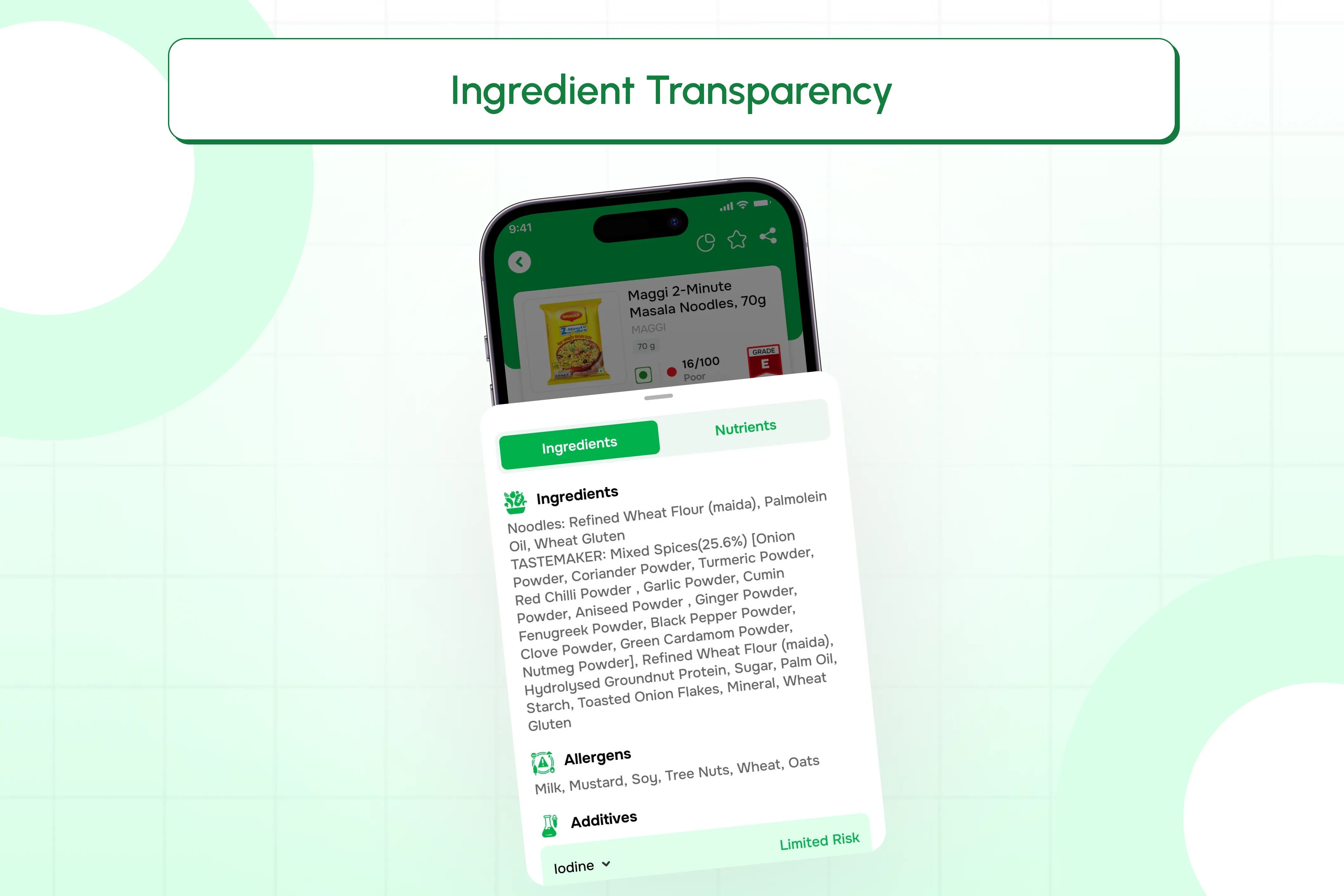
The app doesn’t just list ingredients; it flags concerning ones. High fructose corn syrup? Flagged. Palm oil? Noted. Artificial colors and preservatives? Highlighted. You immediately see which ingredients might not align with your health goals.
4. Healthier Alternatives

Found a product with low health ratings? Don’t worry — FactsScan’s smart AI instantly suggests healthier alternatives. Discover similar products with better nutrition scores, fewer additives, and cleaner ingredients — so you can make the smarter swap in seconds.
5. Detailed Warnings & Insights
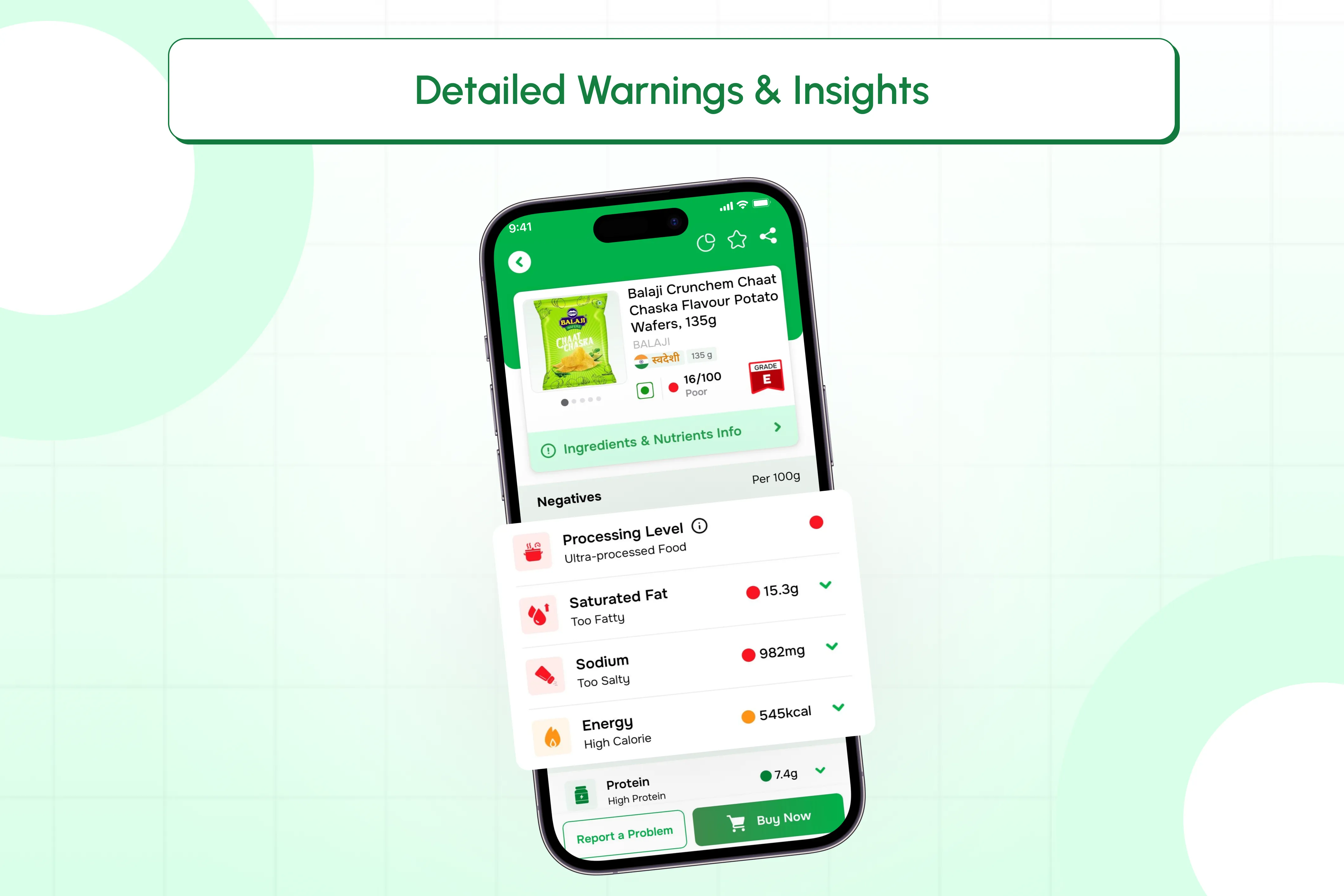
FactsScan goes beyond basic nutrition facts. It identifies potential concerns like high sodium, excessive added sugars, controversial additives, or allergen risks—giving you the full picture.
The beauty is simplicity. No confusion, no marketing spin—just facts.
Step-by-Step: How to Use FactsScan to Find Healthy Snacks
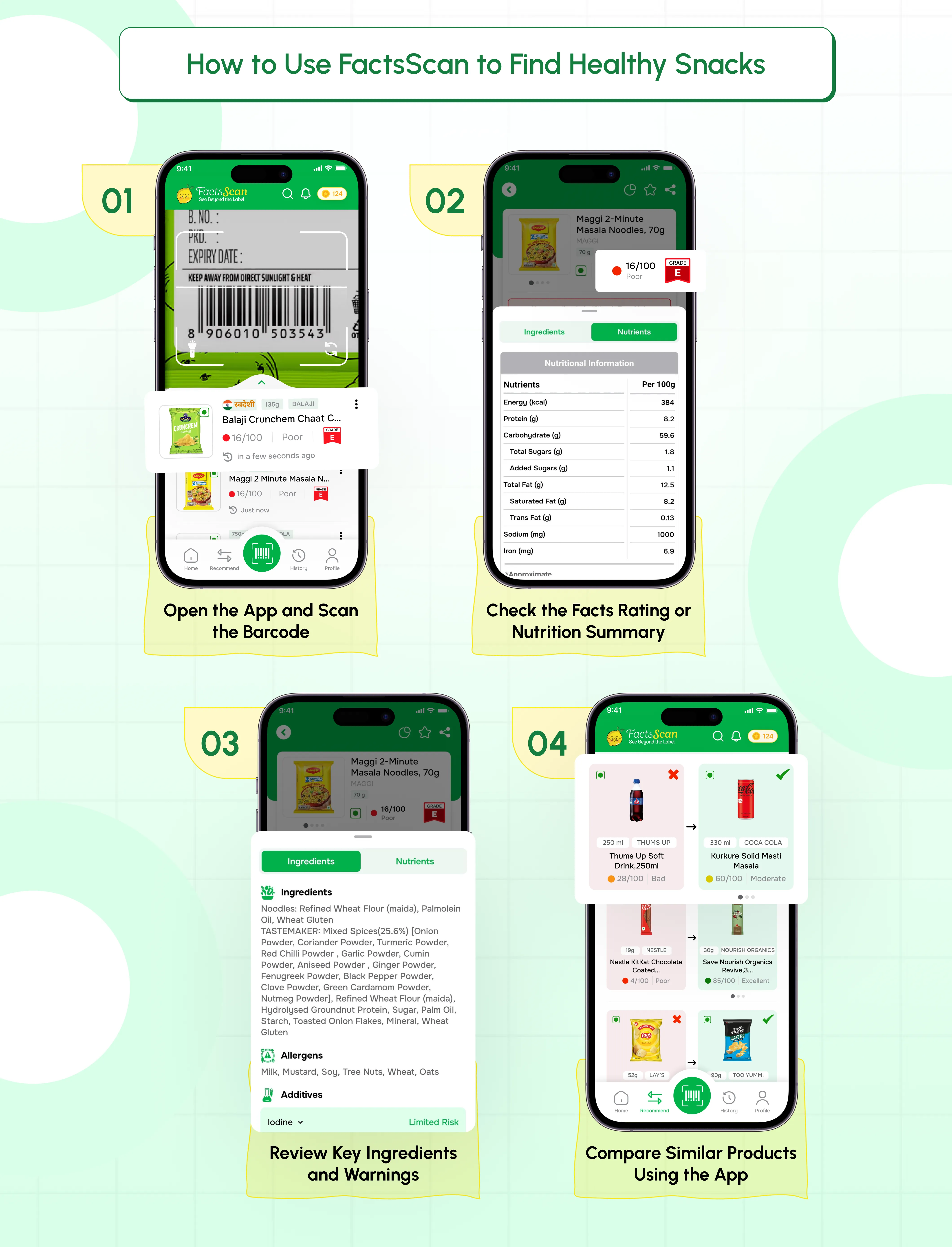
Step 1: Open the App and Scan the Barcode
Launch FactsScan and tap the camera icon. Hold your phone about 6 inches from the product’s barcode until the app recognizes it. Within seconds, the product profile loads with complete information.
Step 2: Check the Facts Rating or Nutrition Summary
FactsScan displays a clear overview of the snack’s nutritional profile. Look at the highlighted metrics first:
- Added Sugar: How many grams per serving? (Aim for under 5-10g for snacks)
- Fiber: Good snacks typically have 2g or more
- Protein: 3-5g helps keep you satisfied
- Sodium: Watch for excessively salty options (over 250mg per serving is high)
Step 3: Review Key Ingredients and Warnings
Scroll down to see the ingredient list and FactsScan’s specific warnings. This is where you’ll discover the hidden problems missed by marketing. Does it contain:
- High fructose corn syrup or excessive added sugars?
- Hydrogenated oils or palm oil?
- Long lists of artificial colors, flavors, or preservatives?
- Ingredients you can’t pronounce?
These red flags often indicate a snack isn’t as healthy as its packaging suggests.
Step 4: Compare Similar Products Using the App
Found two promising snacks? Don’t just pick one blindly. Use FactsScan’s comparison feature to scan both products side by side. Seeing the nutritional differences visually makes it much easier to choose the genuinely healthier option.
Key Things to Look for in a Healthy Snack (With FactsScan Tips)
1. Lower Added Sugar
Added sugar is the silent enemy in packaged snacks. Look for options with under 5-10g per serving. FactsScan highlights added sugars separately from natural sugars, so you know exactly what you’re getting. A snack that gets most of its sweetness from fruit or dates rather than added sugar is a winner.
2. Good Quality Protein or Fiber
These two nutrients slow digestion, keep you satisfied longer, and prevent blood sugar spikes. Healthy snacks should have at least 2-3g of fiber and ideally 3-5g of protein. FactsScan makes it easy to spot which snacks deliver these essentials.
3. Fewer Artificial Additives
Real food has recognizable ingredients. If FactsScan highlights a long list of artificial colors, flavors, or preservatives, that’s a sign to keep looking. Your body recognizes natural ingredients better than lab-created additives.
4. Real, Recognizable Ingredients
The ingredient list should read like something from your kitchen, not a chemistry textbook. Nuts, seeds, whole grains, dried fruit—these are the building blocks of genuinely healthy snacks. FactsScan lets you scan the ingredients quickly without needing a nutrition degree.
5. Balanced Fat Content
Not all fats are bad. Snacks with nuts, seeds, or avocado contain healthy unsaturated fats that support heart health. FactsScan helps you distinguish between beneficial fats and unhealthy trans fats or excessive saturated fats.
Real-World Example: The Cookie Conundrum
Let’s say you’re comparing two snacks:
Option A: “Deluxe Chocolate Chunk Cookie”
The packaging looks indulgent but promises “whole grains.” When you scan it with FactsScan, you discover: 12g added sugar, 2g fiber, refined wheat flour as the first ingredient, and palm oil. It tastes like a treat because, nutritionally, it basically is one.
Option B: “Oat & Almond Energy Bar”
The packaging is more understated, but FactsScan reveals: 5g added sugar, 4g fiber, 5g protein, oats as the first ingredient, and almond butter. Real ingredients, balanced nutrition, genuine health benefits.
The second option wins—but you only knew this because you could see the facts clearly, not because of marketing claims.
Make Smarter Choices, Starting Today
Healthy eating shouldn’t require a PhD in nutrition science. You deserve to know what’s actually in the food you’re buying, especially when companies spend millions on marketing to hide the truth.
FactsScan removes the guesswork. No more standing in the snack aisle for ten minutes, squinting at tiny ingredient lists. No more feeling betrayed when you realize that “healthy” granola bar was mostly sugar. No more wondering whether you made the right choice.
With FactsScan in your pocket, you have a personal nutritionist at your fingertips. You can confidently choose snacks that actually support your health goals—not just taste good and look wholesome.
Your health is too important to leave to marketing departments. Take control of your food choices today.
Download the FactsScan app today and uncover what’s really inside your favorite snacks before your next grocery run. Because you deserve to know the truth about what you’re eating.
Ready to make Healthier Choices?
Download FactsScan now from the Google Play Store and App Store and take charge of your food choices.

Recent Articles
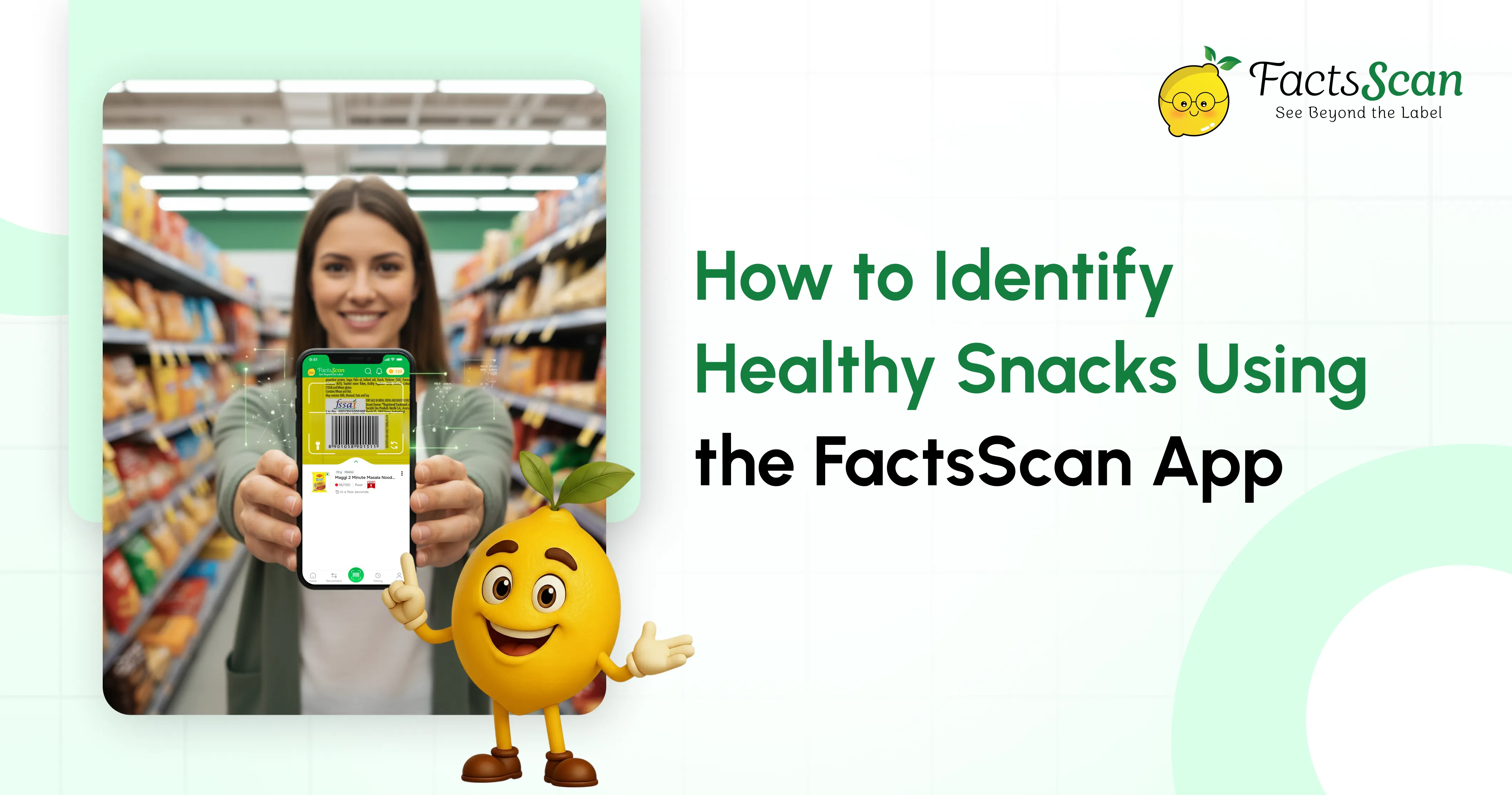
How to Identify Healthy Snacks Using the FactsScan App
Discover how the FactsScan App helps you make smarter snacking choices by instantly analyzing ingredients, nutrition scores, and additives. Learn how this AI-powered tool identifies truly healthy snacks and guides you toward better food decisions with just one scan.
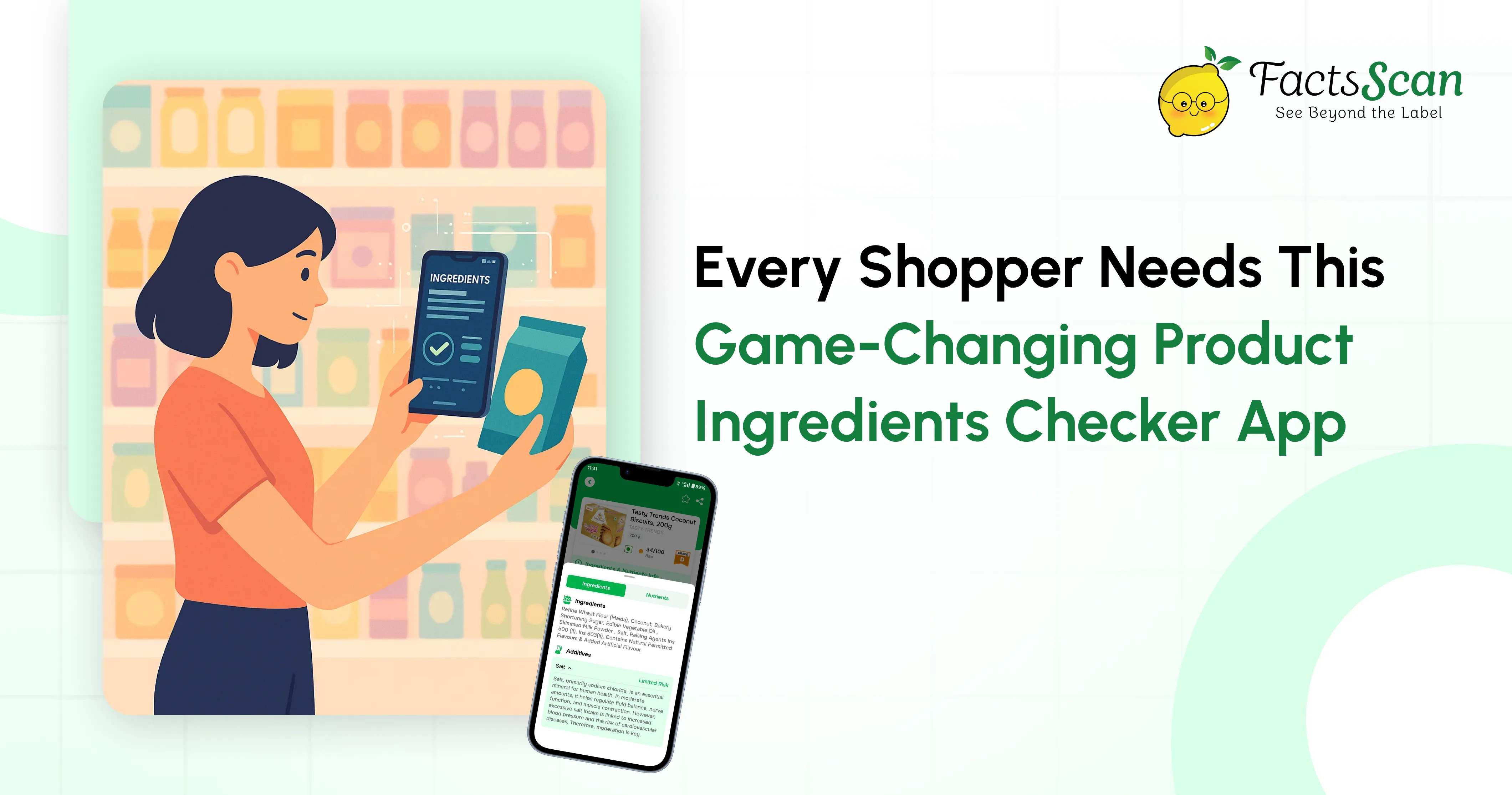
Every Shopper Needs This Game-Changing Product Ingredients Checker App
Tired of confusing food labels and hidden ingredients? This game changing product ingredients checker app helps shoppers instantly scan barcodes to uncover real nutritional facts, health scores, and safer alternatives, making smarter, healthier shopping easier than ever.
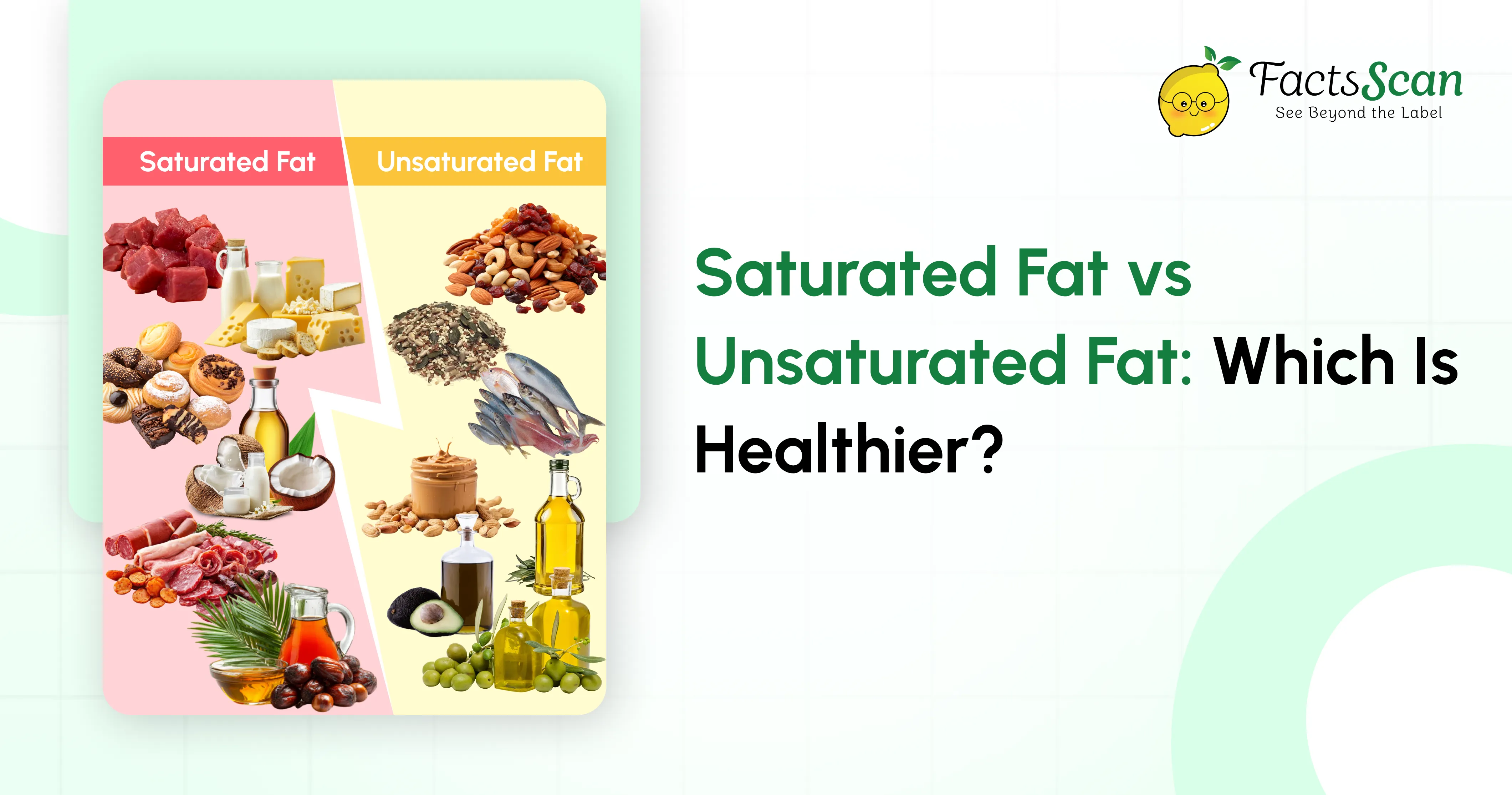
Saturated Fat vs Unsaturated Fat: Which Is Healthier?
Saturated and unsaturated fats affect our health in different ways. While saturated fats—commonly found in meat, butter, and full-fat dairy—can increase cholesterol levels, unsaturated fats, present in nuts, seeds, and vegetable oils, help improve heart health. Prioritizing unsaturated fats over saturated ones can lead to better overall wellness.
 06 Nov 2025
06 Nov 2025 8 Min Read
8 Min Read 






